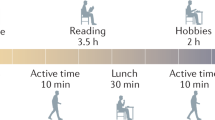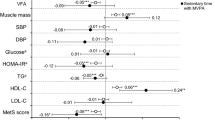Abstract
Sedentary behavior is not a new topic, but trying to examine the direct links between sedentary behavior and health outcomes, independent of time spent in moderate- and vigorous-intensity physical activity, is a relatively new addition to the relationships between physical activity and health. Defining sedentary behavior as a risk factor and target for intervention opens up novel avenues for disease prevention and health promotion. The relationship between sedentary behavior and obesity is complex and not well understood, but the increased risk of disease due to sedentary behavior may be even greater in obese patients. Objective measurement of sedentary behavior is an important link in being able to understand the real effects of being sedentary, and a few measurement devices are described. Interventions targeting sedentary behavior should reduce total sedentary time, break long bouts of sitting with intermittent activity and encourage light-intensity activity throughout the day. New technologies can both measure and deliver an intervention aimed at reducing sitting time, the most common category of sedentary behavior. An optimal activity profile will include minimal amounts of sedentary behavior, in addition to regular physical activity and healthy sleep patterns.
This is a preview of subscription content, access via your institution
Access options
Subscribe to this journal
We are sorry, but there is no personal subscription option available for your country.
Buy this article
- Purchase on Springer Link
- Instant access to full article PDF
Prices may be subject to local taxes which are calculated during checkout

Similar content being viewed by others
References
Pate RR, O’Neill JR, Lobelo F . The evolving definition of ‘sedentary’. Exerc Sport Sci Rev 2008; 36: 173–178.
Hamilton MT, Hamilton DG, Zderic TW . Role of low energy expenditure and sitting in obesity, metabolic syndrome, type 2 diabetes, and cardiovascular disease. Diabetes 2007; 56: 2655–2667.
Objective Measurement of Sedentary Behavior with Accelerometers.. NPAM/EPI Scientific Sessions. American Heart Association: Atlanta, GA, 2011.
Matthews CE, Chen KY, Freedson PS, Buchowski MS, Beech BM, Pate RR et al. Amount of time spent in sedentary behaviors in the United States, 2003–2004. Am J Epidemiol 2008; 167: 875–881.
Owen N, Healy GN, Matthews CE, Dunstan DW . Too much sitting: the population health science of sedentary behavior. Exerc Sport Sci Rev 2010; 38: 105–113.
Healy GN, Dunstan DW, Salmon J, Cerin E, Shaw JE, Zimmet PZ et al. Breaks in sedentary time: beneficial associations with metabolic risk. Diabetes Care 2008; 31: 661–666.
Ekelund U, Franks PW, Sharp S, Brage S, Wareham NJ . Increase in physical activity energy expenditure is associated with reduced metabolic risk independent of change in fatness and fitness. Diabetes Care 2007; 30: 2101–2106.
Ainsworth BE, Haskell WL, Whitt MC, Irwin ML, Swartz AM, Strath SJ et al. Compendium of physical activities: an update of activity codes and MET intensities. Med Sci Sports Exerc 2000; 32 (9 Suppl): S498–S504.
Clark BK, Sugiyama T, Healy GN, Salmon J, Dunstan DW, Owen N . Validity and reliability of measures of television viewing time and other non-occupational sedentary behaviour of adults: a review. Obes Rev 2009; 10: 7–16.
Sugiyama T, Healy GN, Dunstan DW, Salmon J, Owen N . Is television viewing time a marker of a broader pattern of sedentary behavior? Ann Behav Med 2008; 35: 245–250.
Healy GN, Dunstan DW, Salmon J, Shaw JE, Zimmet PZ, Owen N . Television time and continuous metabolic risk in physically active adults. Med Sci Sports Exerc 2008; 40: 639–645.
Dunstan DW, Salmon J, Owen N, Armstrong T, Zimmet PZ, Welborn TA et al. Associations of TV viewing and physical activity with the metabolic syndrome in Australian adults. Diabetologia 2005; 48: 2254–2261.
Dunstan DW, Salmon J, Owen N, Armstrong T, Zimmet PZ, Welborn TA et al. Physical activity and television viewing in relation to risk of undiagnosed abnormal glucose metabolism in adults. Diabetes Care 2004; 27: 2603–2609.
Healy GN, Wijndaele K, Dunstan DW, Shaw JE, Salmon J, Zimmet PZ et al. Objectively measured sedentary time, physical activity, and metabolic risk: the Australian Diabetes, Obesity and Lifestyle Study (AusDiab). Diabetes Care 2008; 31: 369–371.
Healy GN, Dunstan DW, Salmon J, Cerin E, Shaw JE, Zimmet PZ et al. Objectively measured light-intensity physical activity is independently associated with 2-h plasma glucose. Diabetes Care 2007; 30: 1384–1389.
Katzmarzyk PT, Church TS, Craig CL, Bouchard C . Sitting time and mortality from all causes, cardiovascular disease, and cancer. Med Sci Sports Exerc 2009; 41: 998–1005.
Ford ES, Kohl 3rd HW, Mokdad AH, Ajani UA . Sedentary behavior, physical activity, and the metabolic syndrome among U.S adults. Obes Res 2005; 13: 608–614.
Zderic TW, Hamilton MT . Physical inactivity amplifies the sensitivity of skeletal muscle to the lipid-induced downregulation of lipoprotein lipase activity. J Appl Physiol 2006; 100: 249.
Wang H, Eckel RH . Lipoprotein lipase: from gene to obesity. Am J Physiol Endocrinol Metab 2009; 297: E271–E288.
Ekelund U, Brage S, Besson H, Sharp S, Wareham NJ . Time spent being sedentary and weight gain in healthy adults: reverse or bidirectional causality? Am J Clin Nutr 2008; 88: 612–617.
Hawkins MS, Storti KL, Richardson CR, King WC, Strath SJ, Holleman RG et al. Objectively measured physical activity of USA adults by sex, age, and racial/ethnic groups: a cross-sectional study. Int J Behav Nutr Phys Act 2009; 6: 31.
Rosenberger ME . Objective Measurement of Physical Activity with a System of Multiple Wireless Accelerometers. Boston University: ProQuest, Ann Arbor, MI, 2010.
Hart TL, Ainsworth BE, Tudor-Locke C . Objective and subjective measures of sedentary behavior and physical activity. Med Sci Sports Exerc 2011; 43: 449–456.
Kozey-Keadle S, Libertine A, Lyden K, Staudenmayer J, Freedson PS . Validation of wearable monitors for assessing sedentary behavior. Med Sci Sports Exerc 2011; 43: 1561–1567.
Harrington DM, Welk GJ, Donnelly AE . Validation of MET estimates and step measurement using the ActivPAL physical activity logger. J Sports Sci 2011; 29: 627–633.
Albinali F, Intille S, Haskell W, Rosenberger M . Using wearable activity type detection to improve physical activity energy expenditure estimation. Proceedings of the 12th ACM International Conference on Ubiquitous Computing. ACM New York: NY, USA, 2010; pp 311–320.
Lloyd-Jones DM, Hong Y, Labarthe D, Mozaffarian D, Appel LJ, Van Horn L et al. Defining and setting national goals for cardiovascular health promotion and disease reduction. Circulation 2010; 121: 586–613.
Epstein LH, Valoski AM, Vara LS, McCurley J, Wisniewski L, Kalarchian MA et al. Effects of decreasing sedentary behavior and increasing activity on weight change in obese children. Health Psychol 1995; 14: 109–109.
Acknowledgements
M Rosenberger is supported by an NHLBI postdoctoral training grant number 5T32HL007034-35. I thank Bill Haskell and Christopher Gardner for their editorial contribution to this work. Publication of this supplement was partially supported by Nutrilite Health Institute with an unrestricted educational contribution to Stanford Prevention Research Center.
Author information
Authors and Affiliations
Corresponding author
Ethics declarations
Competing interests
The author declares no conflict of interest.
Rights and permissions
About this article
Cite this article
Rosenberger, M. Sedentary behavior: target for change, challenge to assess. Int J Obes Supp 2 (Suppl 1), S26–S29 (2012). https://doi.org/10.1038/ijosup.2012.7
Published:
Issue Date:
DOI: https://doi.org/10.1038/ijosup.2012.7
Keywords
This article is cited by
-
Sedentary behavior and compensatory mechanisms in response to different doses of exercise—a randomized controlled trial in overweight and obese adults
European Journal of Clinical Nutrition (2017)
-
4Ps medicine of the fatty liver: the research model of predictive, preventive, personalized and participatory medicine—recommendations for facing obesity, fatty liver and fibrosis epidemics
EPMA Journal (2014)



